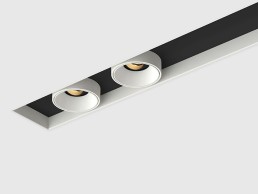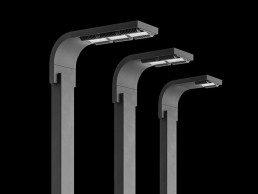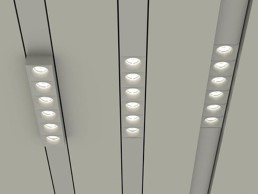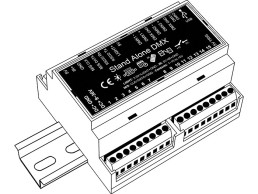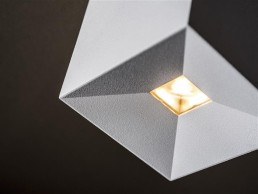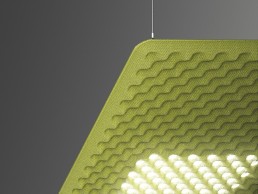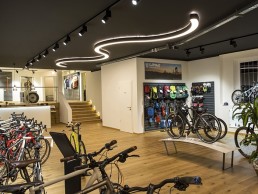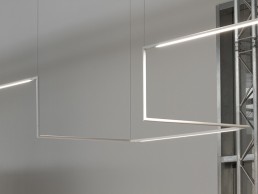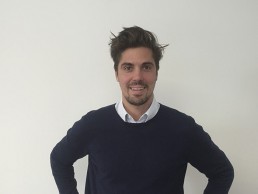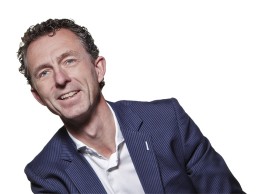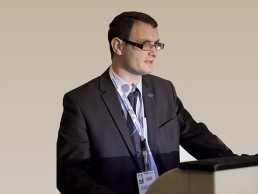Kreon Cana 80
Cana 80 is a recessed profile made of anodised aluminium for use in plastered surfaces. Endless combinations of directional LED light modules, Holon and Prologe, can be placed in the channel. These black or white light modules come in a wide variety of colour temperatures & CRI ratings. Additionally, different reflectors, lenses and dimming protocols are available to meet the needs of each individual project. The combination of light modules is made to measure and is delivered pre-assembled.
Heper Tila S Family
Tila S uses Heper’s Milestone LED module, a surface reflector technology designed to be used for/in different types of road classifications by increasing the number of modules. With the special coating used on the reflector, it supplies higher reflectivity with maximum performance. Milestone has a glare control system, using light indirectly with the multifaceted reflector. Tila S, with one, two and three Milestone LED modules, has a lumen package from 3,400lm - 12,000lm, and is ideal for roads and landscapes with 3000K, 4000K options.
Insta instaLight NoLimit 4033
NoLimit 4033 is based on six profiles and defined light inserts offering great variety. The profiles are designed so the light source is indented, flush or visibly protruding. The generated light is diffuse, direct or glare suppressed and directed by an instalight reflector. It provides a unique matrix for the manifold LED components of the Insta LEDLUX series and supports the latest technologies, for example with Tunable White or dynamic RGB technology.
Chromateq DIN 1024 DMX Interface
DIN 1024, USB to DMX stand alone interface, can now control two DMX universes (input or output). This allows the hardware to work like a splitter mode or receive, in stand alone, a DMX trigger from another DMX device. With the latest firmware, some new RS232 commands complete the trigger capacities. It can also receive fifteen external dry contacts to trigger scenes in memory, be controlled by an infrared remote control or use its internal real time clock for time and calendar scene schedules.
TAL Dice
Dice is TAL’s newest addition to its Think Small collection, a lighting range consisting of lighting fixtures that are modest in size but grand in performance. Dice is a compact, easily installed ceiling-mounted luminaire. In spite of its compact size, Dice is even available with an integrated converter. The block-shaped luminaire is simply clicked onto a small mounting plate attached to the ceiling, leaving no screws in sight. Dice is a clever and compact luminaire with a geometric design, a genuine eyecatcher in every interior.
Artemide Eggboard
Sound-absorbing suspension light, Eggboard consists of two active faces that have been carefully designed by Giovanni Giacobone and Massimo Roj, for maximum acoustic and luminous efficiency. When positioned approximately one metre above head height, the sinusoidal or “egg-carton-like” surface of the lower board absorbs sound whilst the direct emission board - containing low-voltage LEDs adjusted with roto-symmetrical reflectors - ensures maximum lighting comfort.
LEDWORKS Snake
Snake is a modular LED lighting system featuring custom lighting by arbitrary segments of arcs and angles allowing the specifier to create different lighting concepts and custom shapes (curves, circles, etc.). Available as ceiling mounted or pendant fixture with direct/ indirect distribution, Snake is housed in black RAL9006 (other colour on request). Standard not dimmable or DALI/ SwitchDim, incl. converter.
Fluvia Slim System
Slim System is a Josep Lluscà design for Fluvia. It is a suspended system of general flexible lighting. It is very flexible thanks to its versatile accessories that adapt to the installation, allowing vertical growth, 330° swiveling, a light output greater than 80lm/W (complete system) and glare control.
James Murray: Architectural augmented reality
James Murray is Marketing Director at PixelArtworks - a full service projection-mapping studio - and DisplayMapper - a cloud-based media server for permanent projection installations. Here, he gives us this thoughts on the future of architectural augmented reality.
Light has immense potential to change the design of a space. But if you’re a reader of arc, you already know that. What you may not know, though, is that lighting design’s shape-shifting potential is about to get a whole lot more interesting.
That’s because we now have at our disposal a way to make projection-based installations continually change the surface, texture or material of an architectural space on a permanent basis and at the mere touch of a button.
Although it sounds like science fiction, the tools needed to pull off this innovative feat – creative projection mapping combined with cutting edge laser projection – are already in place and aching to be used. We just need a few brave trailblazers to recognise how powerful this combination can be in creating next-generation architectural lighting design.
Projection mapping involves applying projected animations and images across the exact geometry of 3D objects and spaces, but - and crucially - said images have to be augmented to lock precisely onto the environment’s geometry. It’s a technique that tends to leave people awe-struck because it can recreate the physical space of an installation in a virtual space, using 3D software packages. This means all manner of mindboggling effects and animations can be made to interact with their physical environment when projected onto a real world surface. From playing with shadows around ornate features, to water drops splashing on window ledges or architrave; content designed with real-world physics creates something unquestionably magical and bespoke.
If projection mapping sounds a bit technical, it’s because it is. But what the end-user sees is nothing but sheer mind-blowing creativity: a seamless special effect that suspends disbelief to leave people thinking they’re looking at a morphing building; unaware they are, in fact, merely looking at a projected moving image. This is how we can fool the human brain into thinking a building is coming alive.
From transforming the vast rooftop of the O2 arena into a giant blossoming English rose for the 2015 Rugby World Cup, to morphing a theatre set that nurtures a whole new genre of live performance; the art of projection mapping is causing quite a stir in creative circles. The possibilities are near limitless because pretty much any type of image can be used: static photography, otherworldly CG animation and even live data visualisation.
To be fair, projection mapping itself is not radically new. For the past decade, those in the know have been evolving the technique to create some of the world’s most memorable stunts over some of the world’s most memorable buildings. Thanks to projection mapping, we have seen the Sydney Opera House transformed into an animated canvas of Australian indigenous art and we have seen Battersea Power Station’s iconic towers turned into gargantuan speakers.
What is new, though, is the projection technology that underpins these stunning transformations. Until now, projection mapped installations have relied on lamp-based projectors: a solution that has relatively short shelf life because it’s simply not possible to leave a light on for years on end. And we’re not talking about a single lamp or bulb here. To pull off an awe-inspiring, large-scale projection requires a lot. It elevates the “how many lighting designers does it take to change a light bulb?” joke to a whole new level.
The comparatively high-maintenance and expensive nature of lamped projection has been a big barrier for projection installations. There has to be a tangible pay-off if you’re going to invest money, time and effort in a project that can only realistically last a few hours. Fortunately, this quandary may soon be assigned to history thanks to the arrival of a new breed of projector: the laser projector.
We are on the cusp of a revolution in projector technology because lasers have the potential to eradicate antiquated lamps and creatively limiting LEDs. To the uninitiated, this may seem like a granular, geeky detail but its impact on projection mapping is potentially immense. Not only do laser projectors come with the benefits of twice the perceived brightness and minimal maintenance; companies like Panasonic, Christie, Barco, Optoma and others are making them more affordable; and – crucially for the purposes of long term projection mapped installations – they last for years, not hours.
The relative affordability and longevity of laser projectors open up a whole new world of opportunity for projection mapping. Instead of investing heavily in a projection-mapped stunt that, thanks to the short shelf life of lamps, can only last a few hours; laser-based installations can instead be built to last for years. Ergo, you get a whole lot more bang for your buck.
Using lighting design to turn buildings into image-hungry canvases is already ‘a thing’ in glitzy oil-based economies like Dubai and Azerbaijan. Here, they circumvent the problems that come with lamp projections by using LEDs instead. And, somewhat ingeniously, rather than adding them as a surface detail, these LEDs are often embedded into the actual fabric of the building (a great example of why lighting should be considered at earliest stages of architectural design, rather than as an after thought). This means the LEDs can be programmed to conjure up different moving effects, like fire for example, by programming different colour sequences.
Forward thinking though this is, the overall effect is a bit, well, ‘pixelly’. There’s no beating around the bush, images created via sequenced LEDs simply lack the sophistication that comes from a more coherent laser projection. What’s more, when a building is continually covered in LEDs, it can make it hard to appreciate underlying architecture. Whereas projection can add an enhancing layer, rather than obscuring all the hard earned inspiration that went into that beautiful architectural design.
With laser projectors taking large-scale projection-mapped installations from the temporary to the realm of permanent, the next issue is: why? What do vast 3D projection-mapped images bring to an architectural space? The answer is refreshingly simple: they bring magic.
Salesforce turned an otherwise anodyne corporate lobby in their San Francisco HQ into a major talking point. They used giant screens showing interactive video content that was made to look like a waterfall cascading down the walls. The effect is stunning and is an early example of how footfall-dependent destinations like shopping malls, museums and visitor attractions can use these types of visual effects to turn bland spaces into awe-inspiring attractions that draw bigger crowds and ultimately increase revenue.
The problem with this example, though, is that it involved installing a 106-foot, custom-made interactive LED video screen. Not only is such a thing eye-wateringly expensive, it also creates a cumbersome weight-load that can impact on the building’s structure. Perhaps more saliently though, the mere fact that it’s a screen can be a turn-off in itself. In an age where the majority of people in the Western world carry interactive screens in their pockets (thank you iPhone!), their wow factor is, alas, diminishing.
By comparison, projection-mapping is a hassle-free and creatively unlimited solution that’s still new enough to seduce. When it’s applied to architectural spaces, it has the power to transform the appearance of an entire building. If images of wood, glass, cladding or bricks are mapped specifically to a building’s unique geometry, we can create the impression that the building’s fundamental elements are changing on a regular basis. Surely, that’s a show-stopper if ever there was one.
With projection-mapped installations moving out of the temporary and into the permanent, lighting designers, building owners and architects will soon be able to create the illusion of continually changing structures and surfaces. The creative possibilities are electrifyingly endless and you don’t even need a large scale ‘canvas’ to pull it off. Increasingly, businesses are waking up to how this technology can be used to create magic in smaller spaces too. From restaurant table tops to corporate reception areas, no space is too big or too small to benefit from the sheer amazement that goes hand-in-hand with permanent projection-mapped installations.
Adding a digital layer of aesthetic content to physical environments taps into society’s burgeoning appetite for merging the digital into the real world. Early adopters are trembling at the knees over much hyped new tech like the Oculus Rift (a virtual reality headset) and Hololens (Microsoft’s augmented reality goggles that place digital images into the user’s surround physical environment). If their uncontainable exhilaration is an early sign of wider popularity, this marriage of the physical and digital is exactly the type of wow factor that the masses will soon be crying out for.
But in the same way that interactive LED screens limit the creative process with their cumbersome logistics, the bulky headsets that go with virtual and augmented reality act like an interruptive barrier between the user and the aesthetic experience. This minimises the all-important suspension of disbelief and reminds users that what they’re seeing is an illusion; whereas projection-mapped installations don’t require unwieldy headgear to immerse viewers in their mind-bending imagery. The effect is almost like a goggle-free form of augmented reality.
Savvy lighting designers continually strive to bring innovation into what they do. But it’s tricky to constantly be original when new processes and technology rarely come along. So the parallel developments that are going on in projection-mapping and laser projection create a golden opportunity that shouldn’t be missed. When the two are combined, we have a long-term and affordable solution for creating a new genre of lighting design that can stun the whole world. Exhilarating times lay ahead.
Pierre van Lamsweerde
Pierre van Lamsweerde, CEO of Nordeon Group, discusses the company’s business strategy and their most recent acquisition of Lamp Lighting.
It all started with the acquisition of the Philips manufacturing sites. How did this come about?
Varova, our investor, had been studying the lighting market for a long period. The conclusion was clear: midsized lighting companies create significant added value and profitability through their focus and agility. With the changes caused by the transition to LED, the lighting industry was (and is) undergoing a kind of ‘creative destruction’, which offered the opportunity to enter this market and to create a new kind of lighting company: focused and agile through its brand, and strong and perseverant through the scale a group can bring. Thanks to a disinvestment by Philips, the possibility arose for us to lay solid foundation for the development and growth of the Nordeon Group, by taking over one of the largest production sites of LED products in Europe – the plant in Springe, Germany.
What is your role at the Nordeon Group and how did you get there?
After completing my Masters in Economics at the Erasmus University in Rotterdam in 1994, I had been working in various positions at Philips until 2006. After eleven years in consumer electronics, I was orientating myself to change industry, to see if I could add value in a totally different industry. I spoke with the Philips lighting team, who convinced me that lighting was much more than incandescent bulbs, much more than just switching on and off, that light could make plants grow, bring shoppers to spend more in stores, bring safety to city centres and, with the transition to LED, an exciting journey lay ahead, in which my high volume electronics experience could be useful.
I fulfilled various roles, and was given the responsibility of the Retail and Hospitality business for EMEA. In 2011 I got introduced to Patrick van Rossum of Varova, who shared his lighting plans with me, and then at the end of 2012 I resigned in order to start at the Nordeon Group.
Since 2013 I have been CEO of the Nordeon Group. The role has changed a lot since the start, and will continue to do so as we grow the group. In the first year it was building the Nordeon brand, the product portfolio and the commercial teams. Now the role is focused on grasping the synergies that our group offers to the seven brands we have, making sure we have the right people in place, and driving innovation.
You have acquired a number of companies over the last couple of years. What was the strategic decision behind these acquisitions?
We have five different synergies that we pursue within the scope of an acquisition. Synergies can mean introducing new products, technologies and markets into the group. On the other hand the Nordeon Group offers the companies a strong scale: scale in purchasing, scale in sales through a global commercial infrastructure and scale in innovation, all in order to accelerate their own growth dynamic.
Next to products and technologies we also focus on geographic market coverage. You can see this quite strikingly in the Nordeon Group’s most recent acquisition, namely that of Lamp Lighting. With Lamp Lighting’s locations in Spain, Chile, Columbia and Mexico we are tapping into new markets, which until now have been unserved by the Nordeon Group. And vice versa, through the Nordeon Group, Lamp Lighting will grow faster in our key markets like UK, Middle East and USA.
What attracted you to acquire the most recent company, Lamp?
Lamp Lighting presents itself as an extremely attractive business for us. Based near Barcelona, the company has design at heart and combines this with technology and innovation. For me this acquisition is a prime example of a classic win-win situation. It is a successful Spanish company founded and managed by the Cusido family. They had successfully taken their company through the 2008 crisis, and once back in their growth mode, they concluded they would need to partner up in order to remain successful. They realised they needed scale, in purchasing power, in innovation, in market access in order to be able to play according to the new rules in the LED times. On the other hand Lamp Lighting will explore the wide technological and industrial base of the Nordeon Group and market its products via Nordeon Group’s worldwide trade and support infrastructure. All in all, the Nordeon Group and Lamp Lighting enjoy the best growth prospects.
Are there more acquisitions to come?
The pace, with which we have progressed in the last few years, has been very fast – especially last year in 2016. Now we are amongst the top businesses in the lighting industry. It is not our aim to be one of the largest businesses in the industry. We want to be the most agile. The businesses must offer synergies in at least two of five areas mentioned earlier – so if we find more companies that fulfil this, we will add those.
We have to use our sense of proportion – that’s how we have acted so far and that’s how we will continue to act. Last but not least, there is always the question of what possibilities the market has to offer. And that, as you can imagine, is something you don’t always have control over.
Do you plan to change the structure and strategy of the companies Nordeon Group have acquired?
Our strategy is successful so I don’t foresee any changes. We are working more to optimise the structure, to make sure we grasp the synergies, to make sure it’s clear for all of our 1000 employees how things work. So no major changes, but definitely improvements will be implemented. Many established businesses belong to the Nordeon Group – think of Hess providing lighting for outdoor areas or WILA and Schmitz for indoor areas. These are businesses with their own history, their own identity. We strive to protect and strengthen these identities. Of course we have synergies in the group – but these serve to strengthen the businesses and to improve performance and the products themselves. In this way the entrepreneurial scope increases thanks to group membership, as does concentration on core activities – completely in the interests and for the good of the customers.
How do you see the lighting industry developing in the future?
Light is becoming more and more intelligent and a part of our whole infrastructure. In outdoor areas the necessary infrastructure ‘light’ will be used for other functions and tasks – and multifunctional elements, depending on the location of the light, will play an increasingly important role. In indoor areas there will also be strong networking – whether in industrial and commercial sectors or in the private sector.
In short: Smart Home, Industry 4.0 and Smart City will shape light and the luminaires of the future decisively.
David Morgan Review: Isotera
David Morgan takes a look at the Isotera system, which is based on ‘Contactless Power’ technology removing the need for individual drivers thus making connecting LED fixtures as easy as clipping clothes pegs onto a clothes line.
An induction based LED lighting and power transmission system that simplifies the connection of electrical wiring to luminaires, increases system efficiency and extends the working life of LED luminaires is clearly good ‘news’. Surprisingly the underlying principal of induction is quite old and the technology is based on the work of the Hungarian electrical engineer Ottó Bláthy, who invented the transformer in c1885. In this way, distinctly old technology is transforming modern technology some 130 years after its invention.
Isotera, the company that has introduced this system, was formed in 2010 by a team of engineers who were experts in high-density, high-efficiency power conversion and high frequency power networks. Isotera is a spin-off from transformer company Tunewell, which has a history of making radio coils going back to the 1920’s.
The core elements of the Isotera system are a very high frequency power supply; the iHub (operating at 50 KHz); a double insulated twisted pair cable, the iBus; and a power coupler, the iClip, that transfers power via induction from the cables without any need to pierce the insulation.
The iBus cable can be up to 250 metres in length without being effected by voltage drop although the available power drops by around 12 watts per 100 metres. As this is a constant current system, volt drop on long runs is not a problem as it would be with a constant voltage system.
The iClip couplers can be attached and repositioned to the cable very quickly without needing skilled personnel giving the potential to reduce lighting installation costs and time significantly. Changes to wiring layouts and luminaires can be made much more easily than with traditional line voltage systems.
In addition to the standard iClip couplers there is also an emergency version, iEscape, so that an emergency pack with batteries can be connected to the system. No mains supply is needed to the emergency pack as the power comes via the iBus cable. A self-test function is included as standard and potentially any luminaire can be converted to emergency use on the system.
The iClip contains circuitry that converts the high frequency AC into DC power and also a constant current driver to run LED luminaires directly. The drive current is factory set in a range from 200mA up to 2.1 amps with an accuracy better than 1%. A separate 1 – 10V dimming circuit plugs into the iClip with a standard dimming range down to 5%. The dimming can be controlled by any industry standard 1 – 10V dimming system. At the moment there are two sizes of iClip - 20 watt and 45 watt - with a maximum operating efficiency of 95% at around 75% of full load. The efficiency drops slightly to 92.5% at full load.
It is understood that Isotera are developing a plug in converter for DALI and DMX dimming options that will enable the system to be used in a wider range of projects.
The iHub power supply is available in 250 watt and 500 watt ratings so that a large number of individual luminaires can be run from a single power supply rather than needing one driver per luminaire thus reducing the cost. Up to 50% of failures in LED lighting installations are due to driver issues. By separating the power supply from the driver circuit, the reliability increases significantly and Isotera offer a 10 year warranty and a 100,000 hour life expectancy.
Isotera are claiming high levels of efficiency for their luminaire range of up to 165 lumens per system watt when used in conjunction with the Isotera power system.
Other system components include an occupancy sensor that draws power from the iBus and a biased switch interface that generates a 1 – 10V signal allowing manual dimming from a wide variety of standard switch plates.
The system has a number of inbuilt safety features. If the iHub becomes disconnected from the iBus for any reason it will automatically shut down and if the luminaire is not connected to the iClip prior to attaching to the iBus that also will cause the system to shut down.
Isotera initially partnered on an exclusive basis with one of the major international lighting companies with the aim of working with lighting specifiers on a project basis. The company is however now working directly with end-users via wholesalers and focusing on the commercial, industrial and other functional lighting sectors with their own range of LED luminaires.
The Isotera luminaire range includes downlights, festoon lights, recessed ceiling panels and retrofit light engines in various formats. These luminaires all incorporate the iClip, making installation very simple.
Working with end users in the short term should help Isotera build market share along with awareness of the company and the benefits of induction lighting. In the medium to longer term it is understood that Isotera is aiming to work directly with luminaire manufacturers on a non-exclusive basis enabling a much wider range of lighting equipment to benefit from an induction system.
The Isotera system is highly compatible with LED luminaires and offers a wide variety of useful benefits in terms of installation cost reduction, increase efficiency and longer life.
Adoption by the conservative electrical contracting industry seems to be taking longer than expected but the potential for cost and time saving should overcome this resistance in due course.
Lighting manufacturers will also benefit from using the Isotera system with their luminaires, but although using a single source technology always poses issues of continuity this is unlikely to be a major issue. I am keen to explore the system in more detail with our own luminaires and lighting systems as it could be a good fit in many cases.
David Morgan runs David Morgan Associates, a London-based international design consultancy specializing in luminaire design and development and is also MD of Radiant Architectural Lighting.
Email: david@dmadesign.co.uk
Web: www.dmadesign.co.uk
Tel: +44 ( 0)20 83404009
© David Morgan Associates 2017
Geoff Archenhold: Lighting in retail - where to next?
With LED lighting and controls now responding to retailer’s needs, the lighting industry looks to be fully entwined with this sector. Dr Geoff Archenhold outlines the latest trends in the world of retail lighting, providing a glimpse of its potential future.
LED lighting and controls are responding to retailer’s needs. The LED industry is now fully entwined with the retail sector providing high quality lighting and innovative controls however the digital lighting revolution is creating new marketing opportunities through VLC and BLE.
The retail lighting market has always been dynamic even prior to the adoption of LED technologies. But retail fashion is moving faster than ever with competition amongst retailers rife, driving the need for innovative LED lighting solutions that can draw customers into the retail outlet, create a good first impression, guide customers through the store, focus attention on specialty products, make prices and instructions visible and easy to read, appeal to the target consumers, make merchandise easy to evaluate, assist in making purchase decisions and provide a pleasant and efficient experience to consumers.
The latest trends in the world of retail lighting provide a glimpse of the future of how lighting and control technologies may influence the retail experience.
LED power spectral density is important for retail applications
The spectral quality of the LED lighting has a significant impact on attracting, retaining and ultimately enabling a customer sale. In recent years the LED production technology has matured and today LED manufacturers are able to offer specific spectral densities for retail applications.
Lumileds
Lumileds introduced its FreshFocus Technology dedicated to illuminate red meat, marbled meat and fish, bread and pastries with light spectrums that show a range of food items in a highly appetising way. The FreshFocus Technology is part of the LUXEON Stylist Series, Lumileds transformative line of LEDs designed to provide the perfect lighting environment for fashion retail, fresh food and restaurants.
Grocery items are notoriously difficult to light as product colour is a key consumer decision making process to purchase any goods and I certainly know if meat looks brown or if vegetables such as tomatoes look dull I’ll skip purchasing them. The FreshFocus Technology has been designed by accentuating the natural colours of fish and meat items by identifying the ultimate colour point to bring out the characteristics of various foods. For instance, LEDs with a cool daylight tone of 6,500K on the black body curve best accentuate the natural colours in fresh fish. For red beef, a below blackbody colour point at an ultra-warm, 2,200K colour temperature makes the reds appear rich and vibrant. Marbled meats appear best when lit with LEDs at a below blackbody 3,500K colour temperature. With below blackbody colour points, a higher colour gamut enables more fully saturated colour depiction.
Interestingly, Lumileds state improved lighting has been shown to increase sales and provide a return on investment in about a year because the lighting helps reduce unsold or expired meat that would have typically been thrown away.
The FreshFocus Technology for red meat and fish are available in LUXEON CoB 1208 and 1211 arrays, which produce 2,000 and 2,800 lumens when driven at 900 mA and 1,200 mA, respectively. In addition, linear luminaires such as T5 or T8 equivalent lamps can be created by the LUXEON 3014 LED.
For bread and pastries fresh food applications, Lumileds provides the LUXEON CoBs at a CCT of 2,700K, the LUXEON CoB 1208 and 1211 arrays achieve >100 lm/W efficacy and produce 3,464 and 4,750 lumens when driven at 900 and 1,200 mA, respectively.
Nichia
Nichia offer a range of LED emitters specifically designed for retail applications including Meat (M2), Produce (M3) and White Fabrics (M7). Nichia, known for inventing white LEDs, was originally the leader in Phosphor technology and has combined its position in both to enable high quality emission spectra.
The M2 emission spectra provides a high quality of light specifically on red wavelengths and adjusting the white spectrum colour coordinates to prevent a “yellow” white appearance that can make meat look less vibrant and appealing.
The M3 LED emitter emphasises the primary Red, Green and Blue parts of the emission spectrum to achieve the highest quality of colour under general illumination and is ideal for colour applications such as illuminating fruits, vegetables, flowers and produce.
The M7 LED emitters emphasise the white by adjusting the colour and spectrum to produce vivid whites without the need to use near UV like others achieving the effect using a novel phosphor mix only.
Luminus
Luminus, through its generation 3 CoB LED arrays, demonstrated a leadership in terms of efficacy for demanding retail spot lighting applications by delivering 150 lumens per watt at junction temperatures of 85°C. The range comes in various package sizes covering lumen packages from 1,000 lumens to over 20,000 lumens in CCTs ranges from 2,700K to 6,500K and CRI’s of 80 or 90 min. One key area of focus was to ensure tight colour binning of 3-SDCM or less along with AccuWhite high CRI products for multi-colour merchandise and Sensus that creates a purer white light making white objects look cleaner and jewellery sparkle.
Sharp
Sharp has developed the Natural Toning ZENIGATA COB LEDs, which warm the CCT as they are dimmed without the need for complex LED driver technology. Natural Toning technology automatically tunes the colour temperature from 3,000K down to as low as 1,900K as the LED is dimmed. This mimics the behaviour of conventional incandescent sources, which is desirable for instance in hospitality and retail applications.
Natural Toning LEDs from Sharp provide outstanding colour quality, with typical CRIs ranging between 92 and 94 across the dimming range. Warm white and cool white blocks are combined within a single light emitting surface, ensuring uniform colour distribution without the complexity of RGB-array solutions. The spectral fidelity and colour gamut of Natural Toning COBs results in a near perfect reproduction of halogen lamp behaviour.
Intelligent Controls
The use of intelligent controls is going to be a huge trend in retail lighting for many reasons including responding to consumer pressure to reduce a brands impact on the environment, whether it’s through the reduction of waste, the use of renewables or a more intelligent approach to lighting stores.
With intelligent lighting systems and controls, it is possible to divide a store into zones and only use the light that is needed in any particular area at a specific time. If no people are in the vicinity, the environment can be dimmed to save energy. These systems also allow retailers to track energy usage across a store and adjust brightness depending on the amount of daylight available.
The real time nature of the retail environment is now a part of daily life and the use of intelligent tracking systems will allow the retailer to understand consumer behaviours better and predict their shopping habits more accurately enabling improved customer engagement. The so-called ‘Internet of Things’ connects up mobile devices with passive Bluetooth Low Energy (BLE) beacons in the shop, allowing the retailer to guide consumers around the store and send targeted messages and promotions. Individualised prices are also become a possibility through the analysis of shoppers’ previous purchases and the developments of insights over what they may choose to buy in the future.
Data is now intrinsically bound up with lighting. Real-time information can be sent directly to the customer via indoor positioning systems and the LED light network. Useful for communicating product details, discounts and maps, this data is also helpful for staff in terms of managing stock and tracking the impact of changes across the store.
Lextar
Lextar offers a smart location-based service utilising Bluetooth beacon sensors within LED fixtures to create a wireless network that connects to mobile devices. The three main advantages of such a system include:
• Route guidance
• Messaging provision
• User behaviour analysis
The smart LBS system is especially suitable for use in large indoor space such as exhibition venues, shopping malls, museums and airports.
Casambi
Casambi offers a smart control system which uses a Mesh network topology based on Bluetooth low energy.
Casambi have also introduced iBeacon technologies within their modules to enable their partners to introduce fully integrated location based services within their fixtures.
Luminaires with integrated Casambi hardware communicate directly with a handheld device, so there are no wires, and no need to connect to Wi-Fi or install any network hardware. Nor do you need a specialist to install and commission the system – it’s designed to be as simple as possible.
Retailers can save their most commonly used lighting configurations as preset scenes, making it easy to adjust lighting for the whole store.
Casambi’s technology allows the retailer to incorporate smart occupancy sensors into light fittings and harvesting valuable data about how shoppers behave. For example, movement and location sensors can create ‘heat maps’ of a store, revealing which areas get the most footfall and when. This data can help retailers better understand how their customers behave, turning the lighting system into an insight tool that can help drive sales.
Casambi has recently helped German luminaire maker Tobias Grau deal with a rapidly changing array of products at its flagship store in Frankfurt with a system that controls over 100 light points, either individually or in groups.
Acuity Brands
Acuity brands have been the leader in indoor positioning systems using BLE and Visual Light Communication (VLC) since its acquisition several years ago of start-up Bytelight.
Acuity is known to have supplied 100 Target stores in the US with an indoor positioning system using LED lights that can provide in-store location information to guests using the Android version of the Target app with select Android phones.
Philips Lighting
Philips have also undertaken proof of concept indoor positioning and marketing solutions for retail applications with their location of a VLC enabled 8,000 square metre Carrefour location in Lille.
Philips claims that its system can pinpoint a product’s location inside a store to within 10 to 30 centimetres. Its benefits will include reducing the need for staff to guide people, improving conversion rates on promotions, boosting cross selling and engendering customer loyalty.
Geoff Archenhold is an active investor in LED driver and fixture manufacturers and a lighting energy consultant. The views expressed in this article are those of the author and do not necessarily represent the views of mondo*arc.
g.archenhold@mondiale.co.uk


